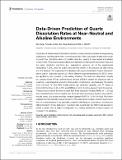| dc.contributor.author | Olivetti, Elsa | |
| dc.date.accessioned | 2022-07-11T18:10:55Z | |
| dc.date.available | 2022-07-11T18:10:55Z | |
| dc.date.issued | 2022-07-06 | |
| dc.identifier.uri | https://hdl.handle.net/1721.1/143652 | |
| dc.description.abstract | Dissolution of silicate-based materials is important to many natural processes and engineering applications, including cement and concrete production. Here, we present a data-driven study to predict the dissolution rates of crystalline silica (i.e., quartz) in near-neutral and alkaline environments. We present a quartz dissolution database containing both dissolution rates and five major dissolution conditions (i.e., temperature, pressure, pH at the experimental temperature T (pHT), and the sodium and alumina content in the solution) via data mining from the literature. We supplement the database with experimental data of quartz dissolution rate in sodium hydroxide solutions (0–5 M) at different target temperatures (25–90°C), which are significantly less covered by the existing literature. We build two data-driven models (i.e., random forest (RF) and artificial neural network (ANN)) to predict the dissolution rate of quartz (i.e., output target) as a function of dissolution conditions (i.e., input features). The results show that both RF and ANN models exhibit high predictive capability, with R2 values of 0.97–0.98, MAPEs of 2.95–4.24% and RMSEs of ∼0.31–0.44 log (mole/m2/s) for the test set. These prediction errors are much smaller than linear regression models (RMSE of ∼1.25 log) also presented here and comparable with those achieved in previous studies using reaction models based on a smaller and less complex dataset (RMSE of ∼0.35–0.44 log). We further evaluate the interpretability and performance of the data-driven models, and the results show that the model predictions are generally consistent with literature observations, including the different impacts of input features on dissolution rate. In particular, the ANN model appears to exhibit a certain level of ability to extrapolate, i.e., making predictions in feature space not covered in the database. | en_US |
| dc.relation.isversionof | 10.3389/fmats.2022.924834 | en_US |
| dc.rights | Creative Commons Attribution 4.0 International license | en_US |
| dc.rights.uri | https://creativecommons.org/licenses/by/4.0/ | en_US |
| dc.source | Frontiers | en_US |
| dc.title | Data-Driven Prediction of Quartz Dissolution Rates at Near-Neutral and Alkaline Environments | en_US |
| dc.type | Article | en_US |
| dc.identifier.citation | Olivetti, Elsa. 2022. "Data-Driven Prediction of Quartz Dissolution Rates at Near-Neutral and Alkaline Environments." Frontiers in Materials. | |
| dc.contributor.department | Massachusetts Institute of Technology. Department of Materials Science and Engineering | |
| dc.relation.journal | Frontiers in Materials | en_US |
| dc.eprint.version | Final published version | en_US |
| dc.type.uri | http://purl.org/eprint/type/JournalArticle | en_US |
| eprint.status | http://purl.org/eprint/status/PeerReviewed | en_US |
| dspace.date.submission | 2022-07-11T17:51:23Z | |
| mit.license | PUBLISHER_CC | |
| mit.metadata.status | Authority Work and Publication Information Needed | en_US |
